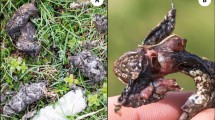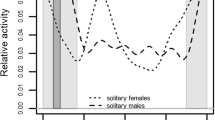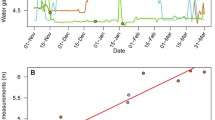Abstract
Arctic Cervids face considerable challenges in sustaining life in a harsh and highly seasonal environment, and when to forage is a key component of the survival strategy. We predict that a cervid maximizes net intake of energy to change the duration of feeding-ruminating cycles depending on season, and pays no attention to light or other activity-entraining cues. Still, in periods of bad weather it may pay energetically to reduce exposure and heat loss. We investigated environmental impact on the seasonal and daily activity pattern of a food-limited, predator-free arctic deer, the Svalbard reindeer. We found that the reindeer indeed had season-dependent feeding-rumination intervals, with no distinct peaks in activity at sunrise and sunset, as would be expected if animals maximize energy intake rates in predator-free environments. However, they temporarily reduced activity when exposed to low temperature and increased precipitation during winter, possibly to conserve energy. We provide insight into the behavioural strategy of Svalbard reindeer which enables them to cope with such an extreme environment.


Similar content being viewed by others
References
Aanes R, Sæther B-E, Øritsland NA (2000) Fluctuations of an introduced population of Svalbard reindeer: the effects of density dependence and climatic variation. Ecography 23:437–443
Agresti A (2002) Cateorical data analysis. Wiley, New York
Albon SD, Stien A, Irvine RJ, Langvatn R, Ropstad E, Halvorsen O (2002) The role of parasites in the dynamics of a reindeer population. Proc R Soc Lond Ser B 269:1625–1632
Bakker ES, Reiffers RC, Olff H, Gleichman JM (2005) Experimental manipulation of predation risk and food quality effect on grazing behaviour in a central-place foraging herbivore. Oecologia 146:157–167
Beier P, McCullough DR (1990) Factors influencing white-tailed deer activity patterns and habitat use. Wildl Monogr 109:1–51
Belovsky GE (1978) Diet optimization in a generalist herbivore: the moose. Theor Popul Biol 14:105–134
Belovsky GE (1981) Optimal activity times and habitat choice of moose. Oecologia 48:22–30
Belovsky GE, Slade JB (1986) Time budget of grassland herbivores: body size similarities. Oecologia 70:53–62
Bergman CM, Fryxell JM, Gates CC, Fortin D (2001) Ungulate foraging strategies: energy maximizing or time minimizing? J Anim Ecol 70:289–301
Blight J, Cloudsley-Thompson JL, MacDonald AG (1976) Environmental physiology of animals. Wiley, New York
Bowyer RT (1981) Activity, movement, and distribution of Roosevelt elk during rut. J Mammal 62:574–582
Burnham KP, Anderson DR (1998) Model selection and inference: a practical information-theoretic approach. Springer, New York
Cederlund G (1981) Daily and seasonal activity pattern of roe deer in a boreal habitat. Swed Wildl Res 11:315–353
Cederlund G (1989) Activity patterns in moose and roe deer in a north boreal forest. Holarct Ecol 12:39–45
Chan K-S, Mysterud A, Øritsland NA, Severinsen T, Stenseth NC (2005) Continuous and discrete extreme climatic events affecting the dynamics of a high arctic reindeer population. Oecologia 145:556–563
Charnov EL (1976) Optimal foraging, the marginal value theorem. Theor Popul Biol 9:129–136
Colman JE, Pedersen C, Hjermann DO, Holand Ø, Moe SR, Reimers E (2001) Twenty-four-hour feeding and lying patterns of wild reindeer Rangifer tarandus tarandus in summer. Can J Zool 79:2168–2175
Conradt L, Clutton-Brock TH, Guinness FE (2000) Sex differences in weather sensitivity can cause habitat segregation: red deer as an example. Anim Behav 59:1049–1060
Cuyler CL, Øritsland NA (1986) Seasonal variations and responses to normal activity of the deep body temperature in the Svalbard reindeer (Rangifer tarandus platyrhuncus). Rangifer Spec Issue 1:81–85
Cuyler CL, Øritsland NA (1993) Metabolic strategies for winter survival by Svalbard reindeer. Can J Zool 71:1787–1792
Cuyler CL, Øritsland NA (2002a) Do seasonal changes in Svalbard reindeer fur have relevance for heat transfer? Rangifer 22:133–142
Cuyler CL, Øritsland NA (2002b) Effect of wind on Svalbard reindeer fur insulation. Rangifer 22:93–99
Cuyler CL, Øritsland NA (2004) Rain more important than windchill for insulation loss in Svalbard reindeer fur. Rangifer 24:7–14
Demarchi MW, Bunnell FL (1995) Forest cover selection and activity of cow moose in summer. Acta Theriol 40:23–36
Demment MW, Van Soest PJ (1985) A nutritional explanation for body size patterns of ruminant and nonruminant herbivores. Am Nat 125:641–672
Derocher AE, Wiik Ø, Bangjord G (2000) Predation of Svalbard reindeer by polar bears. Polar Biol 23:675–678
Erriksson LO, Kallqvist ML, Mossing T (1981) Seasonal development of circadian and short-term activity in captive reindeer, Rangifer tarandus L. Oecologia 48:64–70
Georgii B (1981) Activity patterns of female red deer (Cervus elaphus L.) in the Alps. Oecologia 49:127–136
Georgii B (1984) Activity patterns of free-ranging red deer Cervus elaphus L. Acta Zool Fennica 172:81–83
Georgii B, Schröder W (1983) Home range and activity patterns of male red deer (Cervus elaphus L.) in the alps. Oecologia 58:238–248
Green RA, Bear GD (1990) Seasonal cycles and daily activity patterns of Rocky mountain elk. J Wildl Manage 54:272–279
Hagemoen RIM, Reimers E (2002) Reindeer summer activity pattern in relation to weather and insect harassment. J Anim Ecol 71:883–892
Hamr J, Czakert H (1986) Circadian activity rhythms of chamois in northern Tyrol, Austria. The Northern Wild Sheep Council, Helena, Montana pp 178–191
Hanley TA (1982) Cervid activity patterns in relation to foraging constraints: western Washington. Northwest Sci 56:208–217
Hansen MC (1996) Winter foraging ecology of Dall’s sheep in the Brooks Range, Alaska. Ph.D thesis, University of Alaska, Fairbanks
Hanssen-Bauer I, Kristensen Solås M, Steffensen EL (1990) The climate of Spitsbergen. DNMI-Report 39/90 Klima, pp 1–23
Kastnes K (1979) Svalbardreinens aktivitetsmønster gjennom året (in Norwegian). Cand. scient. thesis. University of Oslo
Kay RNB, Staines BW (1981) The nutrition of the red deer. Nutr Abstr Rev B 51:601–623
Kohler J, Aanes R (2004) Effect of winter snow and ground-icing on a Svalbard reindeer population: results of a simple snowpack model. Arct Antarct Alp Res 36:333–341
Krüll F (1976) Zeitgebers for animals in the continuous daylight of the high arctic summer. Oecologia 24:149–158
Leuthold W (1977) African ungulates. Zoophys Ecol 8:1–307
Loe LE, Irvine RJ, Bonenfant C, Stien A, Langvatn R, Albon SD, Mysterud A, Stenseth NC (2006) Testing five hypotheses of sexual segregation in an arctic ungulate. J Anim Ecol 75:485–496
Maier JAK, White RG (1998) Timing and synchrony of activity in caribou. Can J Zool 76:1999–2009
Major H, Nagy J (1972) Geology of the Adventdalen map area. Nor Polarinstitutt Skrifter 138:
Mangel M, Clark CW (1986) Towards a unified foraging theory. Ecology 67:1127–1138
Mcnamara JM, Houston AI (1986) The common currency for behavioral decisions. Am Nat 127:358–378
Moen AN (1973) Wildlife ecology. W.H. Freeman, San Fransciso
Morschel FM (1999) Use of climatic data to model the presence of oestrid flies in caribou herds. J Wildl Manage 63:588–593
Morschel FH, Klein DR (1997) Effects of weather and parasitic insects on behavior and group dynamics of caribou of the Delta Herd, Alaska. Can J Zool 75:1659–1670
Nilssen KJ, Sundsfjord JA, Blix AS (1984) Regulation of Metabolic-Rate in Svalbard and Norwegian Reindeer. Am J Physiol 247:R837–R841
Øritsland NA (1974) A windchill and solar radiation index for homeotherms. J Theor Biol 47:413–420
Øritsland NA, Alendal E (1986) Svalbardreinen. Bestandens størrelse og livshistorie (in Norwegian). In: Øritsland NA (ed) Svalbardreinen og dens livsgrunnlag. Universitetsforlaget, Oslo, pp 72–91
Owen-Smith N (1988) Megaherbivores. the influence of very large body size on ecology. Cambridge University Press, Cambridge
Owen-Smith N (2002) Adaptive herbivore ecology: from resources to populations in variable environments. Cambridge University Press, Cambridge
Owen-Smith N, Novellie P (1982) What should a clever ungulate eat? Am Nat 119:151–178
R Development Core Team (2006) R: A language and environment for statistical computing. [2.2.0.]. R Foundation for Statistical Computing, Vienna
Reierth E, Stokkan KA (1998) Activity rhythm in high Arctic Svalbard ptarmigan (Lagopus mutus hyperboreus). Can J Zool 76:2031–2039
Schmitz OJ (1991) Thermal constraints and optimization of winter feeding and habitat choice in white-tailed deer. Holarct Ecol 14:104–111
Schoener TW (1971) Theory of feeding strategies. Ann Rev Ecol Syst 2:369–403
Sinclair ARE, Mduma SAR, Brashares JS (2003) Patterns of predation in a diverse predator-prey system. Nature 425:288–290
Skogland T (1984) Wild reindeer foraging-niche organization. Holarct Ecol 7:345–379
Staaland H, Jacobsen E, White RG (1979) Comparison of the digestive tract in Svalbard and Norwegian reindeer. Arct Antarct Alp Res 11:457–466
Staaland H, Øritsland NA, White RG (1988) Digestion of energy and nutrients in Svalbard reindeer. Rangifer 8:2–10
Stephens DW, Krebs JR (1986) Foraging theory. Princeton University Press, Princeton
Tyler NJC (1986a) Reinen i Adventdalen (in Norwegian). In: Øritsland NA (ed) Svalbardreinen og dens livsgrunnlag. Universitetsforlaget, Oslo, pp 143–159
Tyler NJC (1986b) The relationship between the fat content of Svalbard reindeer in autumn and their death from starvation in winter. Rangifer Special Issue No 1:311–314
Tyler NJC (1991) Short-term behavioral responses of Svalbard reindeer Rangifer tarandus platyrhynchus to direct provocation by a snowmobile. Biol Cons 56:179–194
van der Knaap WO (1989) Past vegetation and reindeer on Edgeøya Spitsbergen between c. 7900 and c. 3800 BP, studied by the means peat layers and reindeer fecal pellets. J Biogeogr 16:379–394
van Oort BEH, Tyler NJC, Gerkema MP, Folkow L, Schytte-Blix A, Stokkan KA (2005) Circadian organization in reindeer. Nature 438:1095–1096
van Oort BEH, Tyler NJC, Storeheier PV, Stokkan KA (2004) The performance and validation of a data logger for long-term determination of activity in free-ranging reindeer, Rangifer tarandus L. Appl Anim Behav Sci 89:299–308
Weladji RB, Holand Ø, Almoy T (2003) Use of climatic data to assess the effect of insect harassment on the autumn weight of reindeer (Rangifer tarandus) calves. J Zool 260:79–85
Woods SN (2006) Generalized additive models: an introduction with R. Taylor and Francis. CRC Press, London
Acknowledgments
The field work and data acquisition were supported by the reindeer research projects at the Norwegian Polar Institute. We are grateful to the Research Council of Norway for support to LEL, CB and AM (YFF project) and to Clement Calenge for statistical advice. Finally, we thank Jean-Michel Gaillard, Norman Owen-Smith and two anonymous referees for valuable comments on an earlier version of the manuscript.
Author information
Authors and Affiliations
Corresponding author
Additional information
Communicated by Jean-Michel-Gaillard.
We dedicate this paper to Nils Are Øritsland (born 1939) who died 24th of November 2006 of cancer. Norway lost a real “old-timer” with an extraordinary experience from the Arctic. We have lost a good colleague.
Electronic supplementary material
Below is the link to the electronic supplementary material.
Rights and permissions
About this article
Cite this article
Loe, L.E., Bonenfant, C., Mysterud, A. et al. Activity pattern of arctic reindeer in a predator-free environment: no need to keep a daily rhythm. Oecologia 152, 617–624 (2007). https://doi.org/10.1007/s00442-007-0681-7
Received:
Revised:
Accepted:
Published:
Issue Date:
DOI: https://doi.org/10.1007/s00442-007-0681-7




